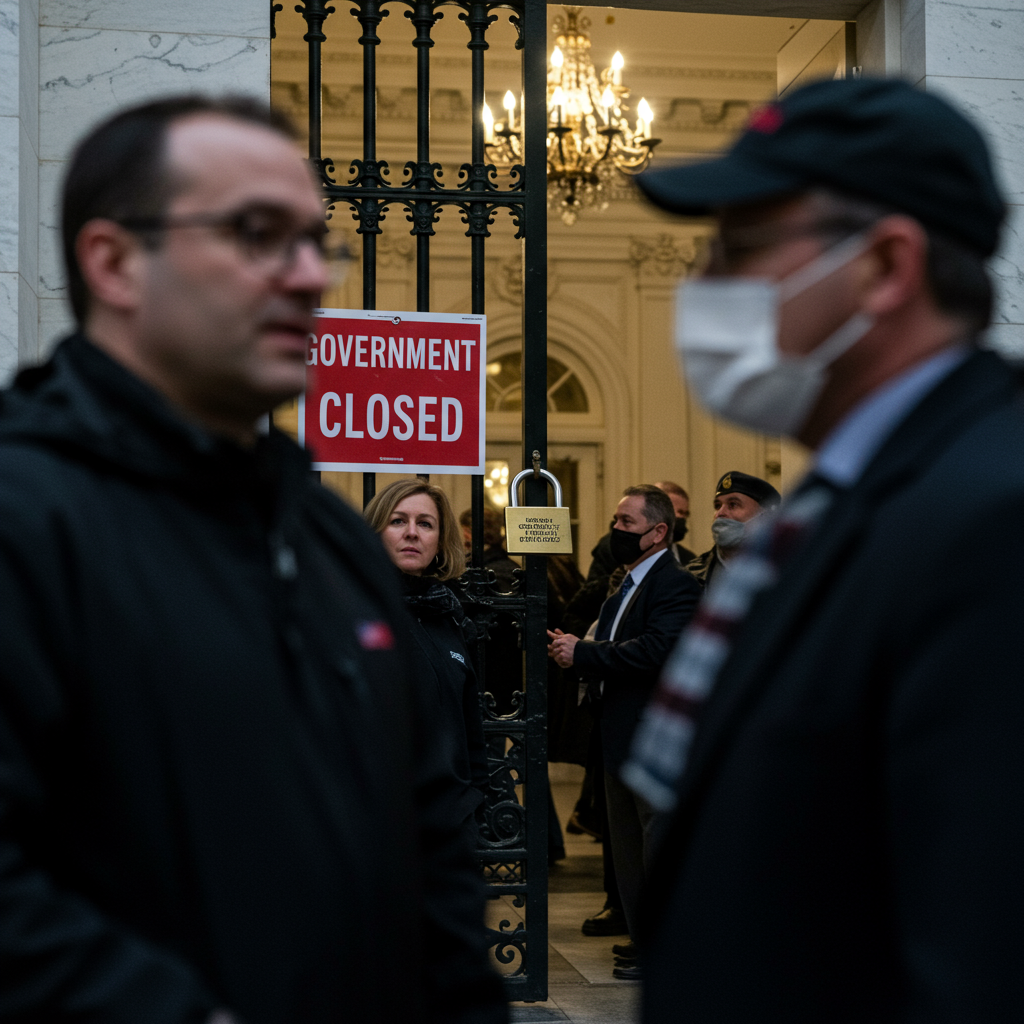As the nation watches, the U.S. government shutdown has now entered its 35th day, marking a grim new record as the longest federal funding lapse in American history. This unprecedented congressional stalemate is inflicting widespread pain, impacting everything from vital food assistance programs to air travel safety, as lawmakers remain locked in a bitter dispute over federal spending. The political impasse shows little sign of an immediate resolution, leaving millions of federal employees and citizens in a state of growing uncertainty.
The Historic Stalemate Deepens
The current government shutdown officially surpassed the previous 35-day record from 2018-2019 on Tuesday evening. Despite repeated efforts, the Senate has consistently failed to advance a House-passed continuing resolution (CR) designed to fund federal operations. The latest procedural vote, the 14th of its kind, saw a 54 to 44 outcome, falling short of the crucial 60 votes needed to move the legislation forward. Strikingly, no new Democratic votes were cast in favor of the measure, underscoring the deep partisan divide.
Only three senators—Democrats Catherine Cortez Masto of Nevada and John Fetterman of Pennsylvania, along with Independent Angus King of Maine (who caucuses with Democrats)—have consistently supported advancing the Republican-led measure. Meanwhile, Republican Senator Rand Paul of Kentucky has been the sole GOP dissenter. This persistent failure “all but guarantees” the shutdown will endure, with no further votes anticipated for the immediate future.
Widespread Impacts on American Life
The ripple effects of this prolonged government shutdown are profound and growing, touching nearly every aspect of American daily life. From essential public services to the broader economy, the consequences are stark and immediate.
Critical Public Services Under Strain
The human cost of the federal funding crisis is becoming increasingly evident. Many essential services, relied upon by millions, are teetering on the brink or already experiencing significant disruption.
SNAP Benefits Crisis: A federal court has ordered the Department of Agriculture to tap into a $4.6 billion contingency fund to provide 50% of November’s Supplemental Nutrition Assistance Program (SNAP) benefits. This intervention came after President Trump’s social media post caused initial confusion, suggesting benefits wouldn’t be paid until the government reopened. White House Press Secretary Karoline Leavitt later clarified that the administration is complying with the court order, though payments for the 42 million affected individuals are expected to face significant delays. This emergency fund is typically reserved for “catastrophes,” highlighting the severity of the situation.
Air Travel Chaos: Transportation Secretary Sean Duffy has issued grave warnings about the future of air travel if the shutdown continues into next week. He predicted “mass flight delays,” “mass cancellations,” and even the potential closure of “certain parts of the airspace” due to a severe shortage of air traffic controllers. Over 3 million passengers have already experienced delays or cancellations since the shutdown began. Unpaid air traffic controllers are calling in sick in rising numbers, impacting at least eight facilities and leading to delays at major airports. Airlines for America, represented by former New Hampshire Gov. Chris Sununu, expressed “extreme concern” for upcoming Thanksgiving holiday travel.
Federal Employees: Over 750,000 federal workers are either furloughed or working without pay. While some workarounds have been implemented, such as active duty military receiving full paychecks, many “dual-status technicians” (National Guard and military reserve unit employees) are still without pay. This widespread financial uncertainty for federal employees is creating significant hardship.
Department of Veterans Affairs (VA): Thousands of VA employees are furloughed. While critical services like medical care and benefit payments continue, regional offices are closed, and support for transition programs has ceased. Even cemetery grounds are not being maintained, and outreach efforts have halted.
- National Parks: Although parks technically remain open, visitor centers and services are severely limited or unavailable, affecting the public experience and safety.
- www.cbsnews.com
- abcnews.go.com
- www.northjersey.com
- www.usatoday.com
- www.northjersey.com
Economic Ripple Effects
Beyond immediate service disruptions, the government shutdown is casting a shadow over the U.S. economy. Polls indicate rising public concern over its impact. The pause on $11 billion in Army Corps of Engineers infrastructure projects in several Democrat-led cities exemplifies the economic drag. The overall financial strain on unpaid federal workers and the uncertainty for businesses reliant on government contracts or services contribute to a broader sense of economic unease.
Healthcare Funding Debate
A significant sticking point in the legislative impasse revolves around healthcare. Democrats are demanding an extension of Affordable Care Act (Obamacare) subsidies to prevent healthcare costs from soaring for millions of Americans. With premium notices already reflecting potential doubling of costs, Democrats view this as a non-negotiable condition for reopening the government.
Political Blame, Calls for Compromise, and the Filibuster Debate
The political rhetoric surrounding the federal budget crisis remains intense, with both parties entrenched in their positions and trading blame.
President Trump has been a vocal presence, particularly on Truth Social. He initially created confusion over SNAP benefits and has consistently urged Republicans to “play tough and play smart.” A key focus of his advocacy is the elimination of the Senate filibuster rule, which requires 60 votes to advance most legislation. Trump believes ending the filibuster would allow Republicans to pass more legislation in his administration’s remaining three years. However, most GOP senators, including Majority Leader John Thune, oppose doing away with this long-standing procedural hurdle.
Senate Majority Leader John Thune expressed cautious optimism for a deal this week. He stated that “there are people who realize this has gone on long enough and there’s been enough pain inflicted on the American people.” Thune has indicated that Republicans have made several offers to Democrats regarding appropriations and a vote on their Obamacare bill, urging them to “take yes for an answer.”
House Speaker Mike Johnson has made his preferences clear regarding the funding timeline. He opposes extending the continuing resolution until December, citing a collective “PTSD about Christmas omnibus spending bills.” Johnson prefers a January deadline, aiming to avoid the pressure of massive year-end funding packages.
Some Republicans, like Senator Markwayne Mullin, believe Democrats might become more flexible in negotiations after Tuesday’s elections. Mullin expressed confidence the shutdown could end as early as Wednesday night or by the end of the week, suggesting Democrats “didn’t want to discourage their base” before the polls. Conversely, Democratic Senator Richard Blumenthal acknowledged “some indication of a thaw” but emphasized Democrats should not compromise on healthcare demands. He questioned the point of enduring the shutdown’s inconvenience if it doesn’t yield substantial benefits for the American people, especially concerning health insurance.
The Senate’s 60-vote filibuster rule remains a central impediment. Despite 14 attempts to pass a funding bill, neither party has mustered the necessary bipartisan support to overcome this threshold. Attempts by both Senate Minority Leader Chuck Schumer to introduce standalone funding bills and Senate Majority Leader John Thune to push the existing House bill have been blocked, illustrating the depth of the legislative impasse.
A Brief Look at Shutdown History
While the current government shutdown feels unprecedented to many, federal funding lapses have a history. Before 1980, agencies often continued operations during funding gaps, with the expectation that Congress would retroactively authorize funds. However, Attorney General Benjamin Civiletti’s legal opinions in the early 1980s established that agencies lacked the authority to operate without appropriations.
President Ronald Reagan oversaw eight shutdowns, though none lasted more than three days. Significant funding gaps occurred between 1990 and 1995. The longest previous shutdown was 35 days (late 2018 – early 2019), which the current crisis now officially surpasses. Prior to that, the 1995 shutdown lasted 21 days. Understanding this history highlights the escalating nature and prolonged duration of the current stalemate. For more on the evolution of these events, consider exploring resources on the history of U.S. budget impasses.
What Lies Ahead? Outlook for Resolution
Despite hints of “some indication of a thaw” in bipartisan discussions, little concrete relief appears immediately in sight. Lawmakers from both parties suggest that the Tuesday elections might serve as a catalyst for renewed negotiations. However, the Senate’s upcoming “state work period” (recess) from November 10-14 looms, threatening to further complicate efforts if a resolution isn’t reached this week.
The ongoing human toll, from unpaid federal workers to delayed SNAP benefits and disrupted air travel, continues to mount. Until a breakthrough in the congressional stalemate is achieved, the record-breaking government shutdown will continue to test the resilience of American institutions and its citizens.
Frequently Asked Questions
What makes this government shutdown historic and why is it happening?
This government shutdown is historic because it officially became the longest federal funding lapse in U.S. history on its 35th day, surpassing the 2018-2019 record. It’s happening due to a congressional stalemate over federal spending, specifically the inability of the Senate to pass a House-approved continuing resolution (CR) that would fund the government. The Senate’s filibuster rule requires 60 votes to advance legislation, a threshold that neither party has been able to consistently meet with bipartisan support, leading to the prolonged impasse.
How are key public services like SNAP and air travel affected during this shutdown?
Critical public services are severely impacted. For SNAP benefits, a federal court order has mandated the use of contingency funds to provide 50% of November benefits to 42 million recipients, though delays are expected. Air travel faces “mass flight delays” and “mass cancellations,” with the potential for airspace closures, as Transportation Secretary Sean Duffy warns of an air traffic controller shortage exacerbated by sick calls from unpaid staff. Over 3 million passengers have already been affected, raising concerns for upcoming holiday travel.
What is the current outlook for resolving the government shutdown this week?
Despite continued failures to pass funding bills, some lawmakers express cautious optimism for a resolution this week, potentially after Tuesday’s elections. Senate Majority Leader John Thune believes a deal is within reach, citing a general realization that the shutdown has lasted too long. House Speaker Mike Johnson prefers a January funding extension to avoid “Christmas omnibus spending bills.” However, the deep partisan divide, particularly over issues like Obamacare subsidies and the filibuster rule, means a swift resolution remains uncertain as both sides continue to attribute blame.



